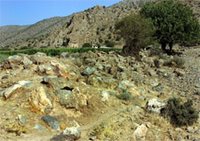Post-Achaemenid Trench Discovered in Bolaghi Gorge

Tehran, 9 April 2006 (CHN) -- Archaeological excavations in Bolaghi Gorge led to the discovery of the remains of a long trench belonging to the post-Achaemenid era. This period was followed by the collapse of the Achaemenid dynasty in 330 BC and lasted to the Parthian era in 150 BC.
“The existence of this trench-like wall was confirmed by geophysical studies and aerial photographs reconfirmed its existence. Therefore, archeological excavations started in area no. 91 of Bolaghi Gorge during which some parts of the wall was unearthed. What has been unearthed so far is almost 3 meters and 17 centimeters in length and one meters and 60 centimeters in height. This wall was constructed from rubbles. Based on the archeological evidence this wall belong to the post-Achaemenid era, however its usage is not known yet,” said Mojgan Seyedein, Iranian head of Iran-Germany joint archaeological team in Bolaghi Gorge.
According to Seyedein, geophysical evidence and aerial photographs indicate that the wall of this trench should have been bigger in size.
Archaeological excavations started in Bolaghi Gorge, located 18 kilometers from Pasargadae historical site in Fars province, when it was announced that the inundation of the newly constructed Sivand Dam will pose a real threat to this historical site which is believed to have been the location of the ancient King Road and one of the most important historical sites of the Pasargadae Complex. With inundation of the dam, 130 historical sites unearthed so far in Bolaghi Gorge, including the newly discovered settlement complexes, will drown. To save the main parts of Bolaghi Gorge before flooding, some joint teams from Iran and foreign countries are currently busy with archaeological excavations in this historical site with the cooperation of Sivand Dam authorities and Bolaghi Gorge Salvation Team.

0 Comments:
Post a Comment
<< Home